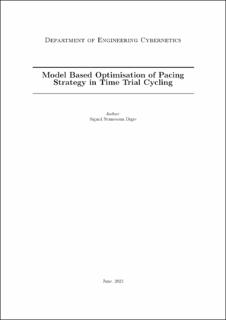| dc.contributor.advisor | Fougner, Anders Lyngvi | |
| dc.contributor.advisor | Tjønnås, Johannes | |
| dc.contributor.advisor | Hanssen, Kristian Gaustad | |
| dc.contributor.author | Digre, Sigurd | |
| dc.date.accessioned | 2023-09-19T17:20:05Z | |
| dc.date.available | 2023-09-19T17:20:05Z | |
| dc.date.issued | 2023 | |
| dc.identifier | no.ntnu:inspera:140443607:35330331 | |
| dc.identifier.uri | https://hdl.handle.net/11250/3090582 | |
| dc.description.abstract | Målet med prosjektet var å finne en optimal effektplan for gjennomføringen av en individuell tidsprøve. Effektplan, i denne sammenheng, er en detaljert instruks for effekt målt på en sykkel. Forfatteren modellerer de fysiologiske prinsippene som ligger til gunn for energibruk i menneskekroppen. Optimeringsprogrammet ble implementert i rammeverket til MATLAB. Prosjektet inneholdt metoder for å estimere parametere som inngår i de fysiologiske modellene, samt verifisering av effektplan på individuelle tidsprøver simulert i programmet Zwift. Resultatet ble en forbedring i tidsbruk i en løype, sammenlignet med en effekplan bestående av konstant effekt på den samme løypen. | |
| dc.description.abstract | The objective of this project is to find optimal pacing strategies for time trial cycling. A pacing strategy, in this context, is based on power output levels measured on an ergometer. The thesis aims to model the energy expenditure of the human body, and set constraints on the system related to these dynamics. Physical tests on the bicycle involves one subject with limited experience cycling. Test protocols are conducted in order to determine parameters describing physical performance of the individual. Using an optimisation framework in MATLAB, a pacing strategy is developed for a certain time trial track. The tests and time trial attempts are all conducted through the use of the training software Zwift, which simulates a cycling environment. The project conducts two iterations of estimating the parameters, and verifying a pacing strategy.
The thesis produced a pacing strategy which proved to have a better time performance than a comparative strategy, set at the same power output throughout the entire time trial. However, results also indicated that the experimental routines of determining physiological parameters could have been more carefully designed and scrutinized. The method of formulating the final pacing strategy also proved an ineffectiveness within the implemented optimal program. | |
| dc.language | eng | |
| dc.publisher | NTNU | |
| dc.title | Model Based Optimisation of Pacing Strategy in Time Trial Cycling | |
| dc.type | Master thesis | |
